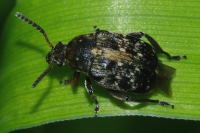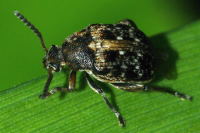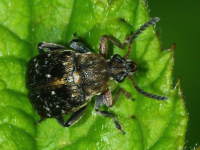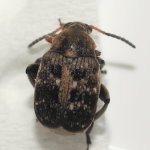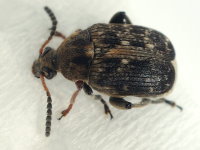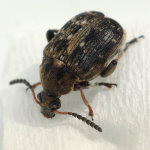Phylum Arthropoda (Arthropods) ➔ Subphylum Hexapoda (Hexapods) ➔ Class Insecta (Insects) ➔ Order Coleoptera (Beetles) ➔ Family Chrysomelidae (Leaf beetles)
Bruchus rufimanus Bohemann, 1833
Ackerbohnenkäfer Broad Bean Weevil
Further vernacular names:
Broad Bean Beetle, Bean Seed BeetleClassification:
Bruchus rufimanus belongs to the subfamily Bruchinae, tribe Bruchini.The seed beetles (Bruchinae) were until recently regarded as an independent family (Bruchidae) within the superfamily Chrysomeloidea.
Distribution:
The species has been introduced into Europe by international trade and has spread worldwide.Description:
Length 4 - 5 mm; underside yellowish brown haired; pronotum with lateral tooth; elytra yellowish spotty haired, often behind the scutellum with reddish-yellow elongated spot; antenna base and forelegs reddish-yellow; middle legs black (rarely with reddish tip of middle tibiae); inside of hind tibiae with long tooth.There are several similar species.
Biology:
The Broad Bean Weevil Bruchus rufimanus forms one generation per year. The development of Bruchus rufimanus, as well as the beginning and end of the diapause are influenced by day length and temperature. In particular, the development of host plants and beetles is closely synchronized.The oligophagous beetles live on legumes (Fabaceae), frequently on vetches (Vicia), and more rarely on peavine (Lathyrus). An economically significant host plant of the species is the broad bean (Vicia faba).
After wintering in sheltered areas, the day-active beetles visit their host plants. The beetles feed on flowers and leaves as well as pollen of the host plants. After mating, the females of Bruchus rufimanus lay their eggs on the young pods of broad beans (Vicia faba) or other suitable host plants. The larvae hatching from the eggs after 1 to 3 weeks bore through the pod wall and develop in the seeds. 2 to 3 months later, after passing through 4 larval stages, pupation takes place. About 10 days later the beetles of the new generation hatch. Bruchus rufimanus hibernates as adult beetle.
References, further reading, links:
- Rheinheimer, Joachim, & Hassler, Michael: Die Blattkäfer Baden-Württembergs, 2018, 928 pages, Kleinsteuber Books (Karlsruhe), ISBN 978-3-9818110-2-5
- Arved Lompe: Die Käfer Europas - Ein Bestimmungswerk im Internet
- Agelastica alni
- Altica sp.
- Aphthona nonstriata
- Bromius obscurus
- Bruchus rufimanus
- Bruchus sp.
- Cassida nebulosa
- Cassida rubiginosa
- Cassida sp.
- Cassida stigmatica
- Cassida vibex
- Cassida vibex/bergeali
- Cassida viridis
- Chrysolina fastuosa
- Chrysolina haemoptera
- Chrysolina hyperici
- Chrysolina lucidicollis
- Chrysolina oricalcia
- Chrysolina sp.
- Chrysolina sturmi
- Chrysolina varians
- Chrysomela populi
- Chrysomela tremula
- Chrysomela vigintipunctata
- Clytra laeviuscula
- Clytra quadripunctata
- Coptocephala sp.
- Crepidodera aurata
- Crepidodera aurea
- Crepidodera fulvicornis
- Crioceris duodecimpunctata
- Cryptocephalinae sp.
- Cryptocephalus moraei
- Cryptocephalus nitidus
- Cryptocephalus pusillus
- Cryptocephalus sp.
- Donacia bicolora
- Donacia cinerea
- Donacia marginata
- Donacia versicolorea
- Galeruca tanaceti
- Galerucella s.l.
- Gastrophysa viridula
- Gonioctena decemnotata
- Gonioctena quinquepunctata
- Gonioctena quinquepunctata/intermedia
- Gonioctena sp.
- Gonioctena viminalis
- Lema cyanella
- Leptinotarsa decemlineata
- Lilioceris lilii
- Lochmaea caprea
- Neocrepidodera ferruginea
- Neocrepidodera sp.
- Oulema melanopus/duftschmidi
- Oulema obscura
- Pachybrachis sp.
- Phratora sp.
- Phratora vitellinae
- Phyllobrotica quadrimaculata
- Phyllotreta armoraciae
- Phyllotreta nemorum
- Phyllotreta vittula
- Plagiodera versicolora
- Plagiosterna aenea
- Plateumaris sp.
- Podagrica fuscicornis
- Psylliodes sp.
- Pyrrhalta viburni
- Sphaeroderma sp.
- Xanthogaleruca luteola
